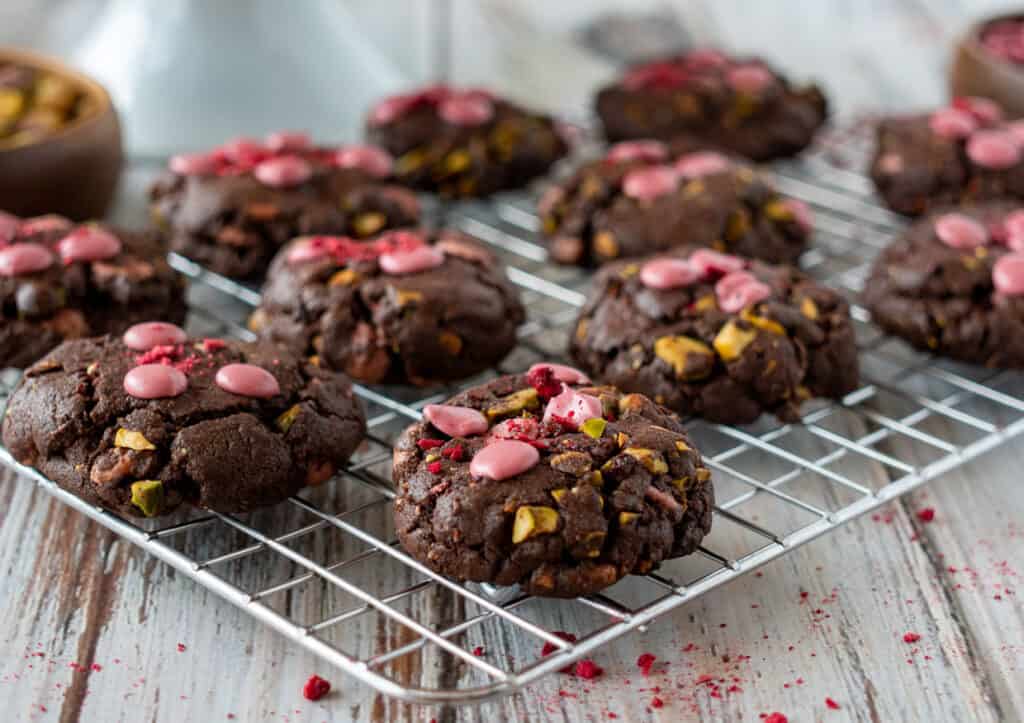Learn about the newest chocolate sensation, Ruby chocolate, which is taking the world by storm!

What is ruby chocolate? This pink-colored chocolate is a type of chocolate just like milk, dark or white chocolate, but with a fun color and fruity flavor. Companies from Starbucks to Crumbl Cookies are jumping on the ruby chocolate bandwagon, and you can too!
Flavor and Color — A Winning Combo
Ruby chocolate has a unique flavor profile that balances fruitiness and smoothness. This, along with its soft and creamy texture, makes it stand out from traditional chocolate varieties like milk and dark chocolate.
But it’s not just the flavor that sets ruby chocolate apart. It is specially blended to create a one-of-a-kind, stunning pink color that is a showstopper.
While you might assume the color is from food coloring, you’d be wrong. The color of this pink chocolate is entirely natural without the addition of food coloring or dyes.
This pink hue is created by the unique blend of cocoa beans used to make the chocolate. The pink color is unlike any other type of chocolate and makes dessert or chocolate treats created with it really stand out.
So Is Ruby Chocolate Really Even Chocolate?
Yes, ruby chocolate is made from cocoa beans, cocoa butter, and sugar. So it meets the definition of chocolate set by the chocolate experts at the International Cocoa Organization. Whether it is an entirely new chocolate category can be debated, but it is definitely chocolate.
Emergence
Ruby chocolate didn’t show up just by chance. A decade of experimentation and research by Barry Callebaut and his Belgian chocolate company, Callebaut, led to its development.
In 2015, Barry Callebaut received a patent for the production process of ruby chocolate, but it still took another 2 years for them to bring the product to market.
The exact production process for ruby chocolate is a closely guarded trade secret by Callebaut Chocolate. The secret is so closely guarded that some people have claimed it isn’t really a new type of chocolate and dismissed it as marketing hype.
Behind the Scenes
The main ingredient in ruby chocolate is the ruby cocoa bean, a variety of cacao plants with a natural fruity flavor. The beans are grown worldwide in areas such as Ecuador, Brazil, and the Ivory Coast.
While we think of chocolate as having a brown color, unfermented cacao beans are reddish-pink. So many cocoa experts think the color and taste are obtained by changing the traditional fermentation process.
Citric acid is also used during the processing of ruby chocolate. Chocolate experts think it also helps enhance the natural fruitiness of the cocoa bean and the pink color.
Compared to the Rest
You might wonder how ruby chocolate compares to other types of chocolate you are already familiar with, like milk chocolate, dark chocolate, or white chocolate.
Besides the noticeable color difference, there are some distinctive variations.
- Cocoa content: Like dark chocolate, ruby chocolate has a high cocoa content. However, it has a lower cocoa butter content, making it creamier and smoother in texture. It also doesn’t have the bitter aftertaste some people find in dark chocolate.
- Flavor: Ruby chocolate has a distinct berry-fruitiness to its taste, which sets it apart from milk chocolate’s creaminess and dark chocolate’s intensity. Some people describe the flavor as similar to berries like raspberries or strawberries.
Where Can You Find Ruby Chocolate?
Since its introduction in 2017, ruby chocolate has become quite popular. It can be hard to come by in traditional grocery stores, but it is relatively easy to find online.
Ruby chocolate’s unique flavor and pink color make it a popular choice for adding novelty to desserts and chocolate treats.
Because of this, some companies have started using it to make ruby chocolate products, which has increased its popularity. In 2020 Starbucks added a bright pink Ruby Flamingo Frappuccino to its menu, and Crumbl Cookies features a Ruby Chocolate Chip Cookie periodically.
Why Is Ruby Chocolate So Expensive?
Ruby chocolate is only made by one chocolate manufacturer, Callebaut. The chocolate is made from a particular type of cacao bean and has a unique production process. So it is expensive to make and not widely produced, both of which can result in higher prices.

In the Kitchen
Restaurant chefs, bakers, and home cooks are also experimenting with ruby chocolate in their creations. It can be used in many of the same ways as other types of chocolate.
- Melt it and use it as a coating or mold it into candies. Top off a cake with a chocolate ganache.
- Grate or use it to make chocolate curls for decorating a cake or tart.
- Chop it up and add it to baked goods, like ruby chocolate chip cookies.
- Add it to brownie batter for fruity, berry-flavored brownies or blondies.
- Make homemade ice cream with ruby chocolate and berries for a delicious dessert.
Ruby chocolate can be tricky to work with because it is softer and creamier than other chocolate. This means it doesn’t hold its shape well when melted.
And its pretty pink color can also turn dull and grayish at higher temperatures, so baking with it requires some care and experimentation.
What Is Ruby Chocolate?
Ruby chocolate is a unique and exciting addition to the chocolate world. Its flavor, texture, and color set it apart from other chocolate, and it’s worth seeking it out to enjoy this new chocolate flavor. Whether you’re a fan of chocolate or just looking to try something new, ruby chocolate is definitely worth a taste!
Anne Jolly is the creator of the food blog Upstate Ramblings. She loves to cook with gadgets like an air fryer, sous vide or pressure cooker. In her free time she enjoys hiking, reading, knitting and spending time with her three kids.